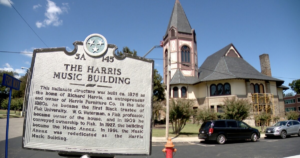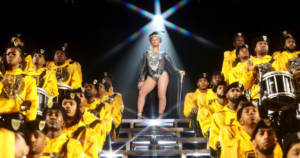
Started just eight years ago, Brazil’s Rios de Historia cultural tour has attracted thousands of travelers from the U.S. and abroad, giving tourists a once-in-a-lifetime look at the nation’s most dazzling historic and cultural sites.
The best journeys tend to occur off the beaten path, however, and the “Rivers of History” tour does not disappoint when it comes to sightseeing in Brazil’s less-traveled regions — especially those teeming with African history, culture and influence.
While must-see cities like Salvador and Rio de Janeiro tout some of the larger populations of Afro-Brazilian locals, tour concierge Rosane Lucas said there are still aspects of the region’s Black history that remain untold.
“I’m Black, and I noticed that Rio de Janeiro is missing this part [of our history] a lot,” said Lucas, who runs one of the only tours in Rio exploring the city’s African history. “We have a lot of Black people here, but we’re not very recognized. … So, I decided to do something for my people.”
The Brazil native partnered with organizers and knowledgeable teachers from Rios de Historia to create an educational tour that focused on the former Olympic city’s Black/African roots. She emphasized that the tours are not only about sightseeing but also about immersing oneself in the area’s Black history and culture.
“I had this dream to do these kinds of tours here to represent [Black people],” Lucas said. “That’s the point. We must recognize it, and we must know about our culture.”
Among the tour’s unique sites is the Instituto Prestos Novos (the New Black People Institute), one of the most significant archaeological sites in Brazil where a slave cemetery was found inside a home in the heart of the port region in Rio. Tourists also can take a walking tour of downtown to visit the Valongo Pier, the key arrival port for enslaved Africans in Brazil. Over 500 enslaved workers from the Congo, Angola and other African nations arrived at this port in 1811, according to Rios de Historia.

Bitter reminders of the transatlantic slave trade still permeate the Portuguese-speaking nation today, as an estimated 4.6 million enslaved Africans were remanded to Brazil, the latest research from Atlanta’s Emory University uncovered. Close to two million Africans in bondage were placed in Rio de Janeiro between 1500 and 1856, their labor helping to drive the economy for decades.
Other stops along the trail routes include el Pedro do Sal, or the Salt Stone, where the world-famous Samba dance was born; the coffee farms in Barra do Piraí; and a site teaching the traditional Brazilian martial art of capoeira.
 Rios de Historia tour creator Raul Melo said that, nowadays, 90 percent of the company’s clients are American, as it has been contracted to become the primary tour company for many U.S. universities and companies.
Rios de Historia tour creator Raul Melo said that, nowadays, 90 percent of the company’s clients are American, as it has been contracted to become the primary tour company for many U.S. universities and companies.
“As a son of people from Salvador and Bahia, my childhood interest in Afro history in Brazil has since developed my knowledge to be a expert for the theme,” Melo said.
Melo, who also serves as a teacher on the tours, went on to give more information regarding the company’s Afro-Brazilian excursions and discussed the roles that slavery and African history and culture have played in shaping Brazil into the country it is today.
ABS: How long does the walking tour take? Is there more outside of the tour that tourist can visit to learn more about Brazil’s history?
Melo: Our Afro Tour is around four hours. We walk in Gamboa, downtown, the slave’s church and trade streets. It’s possible to understand the evolution of the city with the influences from Africa, Portugal and France, and during this time, we’ll compare the Brazilian slavery with American slavery.
ABS: When was The Instituto Prestos Novos discovered and how is the city working to restore and preserve the history from the cemetery and other historical places around Rio?
Melo: The archaeological site was discovered in 1996 under the house of a family during the reform of the new Black cemetery that was created for those who did not survive the crossing between Africa and Brazil. With the creation of a cultural center there, the institute was able to offer various workshops on Black culture and historical episodes of Brazilian history. For many years, the institute lived on donations but [they] did not cover its costs. There was a possibility of closing its activities, but the center soon received financial help.
ABS: Approximately how many enslaved Africans were found buried in the Instituto Prestos Novos?
Melo: We do not have an exact number because the bones were in fragments. In fact, the archaeological site found under the house where today is Instituto Prestos Novos is only part of the former slave graveyard in the Gamboa neighborhood. This region is known as Little Africa.
 ABS: What impact(s) did the transatlantic slave trade have on the Brazilian economy?
ABS: What impact(s) did the transatlantic slave trade have on the Brazilian economy?
Melo: While several countries industrialized, Brazil continued to be agricultural during the industrial revolution age. The slave was the main labor force of the Brazilian economy — initially with the sugar cane cycle, through the extraction of gold and, finally, at the height of the coffee plantations, Brazil did not move without the African slave. Even after its abolition in 1888, the Brazilian empire would lose much of its political force, which would help the arrival of the Republic in 1889.
ABS: In what ways, if any, did the slave industry in Brazil mirror that of the United States’ chattel slavery?
Melo: During the colonial period, Brazil was closed to any social or economic exchange. As a colony, the only contact with [the] metropole was Portugal. With the arrival of the royal family to Brazil, [there was a] strong English influence in our economy once the ports were finally opened to friendly nations. However, the contact with the USA was very timid. Only after 1860 was there a beginning of business contacts, [but] nothing related to Black culture.
ABS: Can you describe the sound of Samba and how that music and dance is distinct compared to other types of music that originate from Brazil?
Melo: In Brazil, there are different types of music. The country has continental dimensions and, obviously, diverse cultures. The original samba comes from Bahia in African rhythms of the Bahian slaves. After the abolition of slavery, the [rhythms] moved to Rio de Janeiro, where they suffered several variations and began to be played in private parties in the women’s houses, called tias, in the neighborhood of Gamboa. The playing of samba was the law at the time and even was played at private festivities. The samba represented and kept Black culture alive.
ABS: How has African culture influenced Brazilian culture today?
Melo: The influence of Black culture is present in the daily life of all Brazilian society; in the cooking, dress, music and history. From the beginning of our colonization the mixture of races is part of the characteristic of our country. We do not have an ethnic face, but we are all races. The cities of Salvador and Rio de Janeiro, the first capitals, saw the most African influence because they had ports that received slaves directly from Africa. Salvador is currently the only city outside [‘Little Africa’] with the highest percentage of Black Brazilians.










More Stories
The Importance of HBCUs as They Grow in Popularity (VIDEO) – Scripps News
Biden Campaign Plans Black Media Rollout To Reach Black Voters – BET
Black college president says it's time to fix Black-Jewish relations – The Washington Post